Product Images Pregabalin
View Photos of Packaging, Labels & Appearance
- Pregabalin Capsules 50 mg (#30) - PDP 106
- Figure 1 - pregabalin fig01
- Figure 2 - pregabalin fig02
- Figure 3 - pregabalin fig03
- Figure 4 - pregabalin fig04
- Figure 5 - pregabalin fig05
- Figure 6 - pregabalin fig06
- Figure 7 - pregabalin fig07
- Figure 9 - pregabalin fig08
- Figure 10 - pregabalin fig09
- Figure 11 - pregabalin fig10
- Figure 12 - pregabalin fig11
- Cockcroft and Gault equation - pregabalin formula
- Chemical Structure - pregabalin str
Product Label Images
The following 14 images provide visual information about the product associated with Pregabalin NDC 45865-106 by Medsource Pharmaceuticals, such as packaging, labeling, and the appearance of the drug itself. This resource could be helpful for medical professionals, pharmacists, and patients seeking to verify medication information and ensure they have the correct product.
Figure 2 - pregabalin fig02
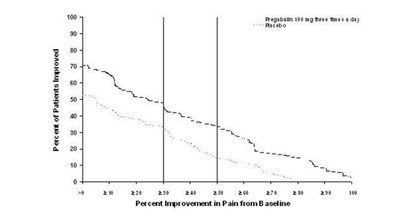
The text refers to a table that includes the percentage of improvement in pain from the baseline for patients who took Pregabalin 160 mg for three days. The table also includes numbers such as 100, 2, 10, 220, 23, and 280. However, the purpose and context of these numbers are not clear. The text is not completely readable and some words are incomplete, making it confusing to interpret.*
Figure 5 - pregabalin fig05
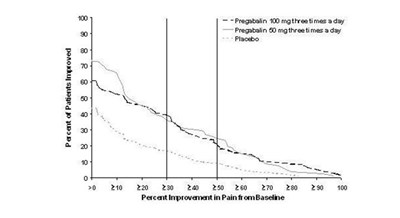
This appears to be a chart that compares the effectiveness of three different treatments for pain: Fregabalin at 100 mg three times a day, Pregataiin at 80 mg three times a day, and a placebo. The table shows the number of patients who improved after receiving each treatment and a graph indicating the percent improvement in pain from baseline. It is unclear what the specific pain condition being treated is, and there may be further information missing.*
Figure 6 - pregabalin fig06
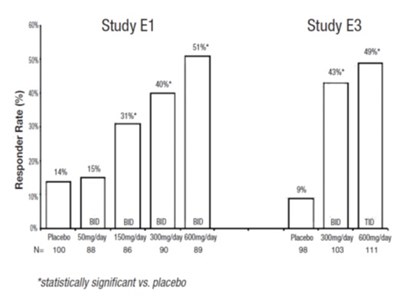
The provided text is a table with two studies named L Study E1 and Study E3. The remaining text contains some numerical and character values, which are not indicative of any clear description. Thus, the description is not available.*
Figure 9 - pregabalin fig08
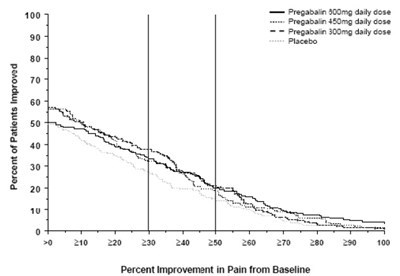
The text provides a graph showing the percent improvement in pain from baseline for patients taking Pregabalin at 300mg and 450mg daily doses, compared to a placebo. The data is shown on a scale from 0 to 100 with increments of 10, and the x-axis shows the range from 20 to 280. The text could be useful for medical professionals evaluating the effectiveness of Pregabalin in pain management.*
Figure 10 - pregabalin fig09
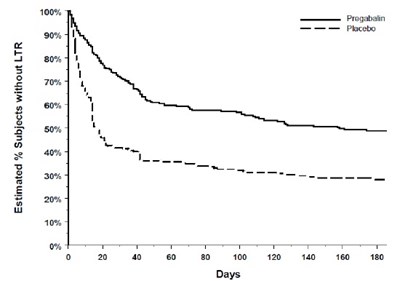
This appears to be a table showing estimated percentages of subjects without LTR ("Lost to Follow-up") over time, with two groups: Progabain and Placebo. The percentages range from 0% to 100%, with corresponding days listed along the bottom row. Without more context or information it is unclear what the purpose or study involved is.*
Figure 12 - pregabalin fig11
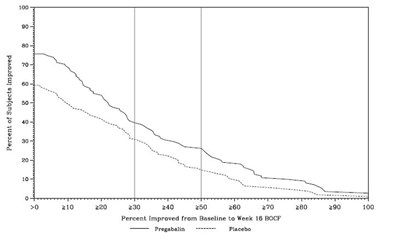
This appears to be a table with data showing the percent of subjects who improved after taking either pregabalin or a placebo medication. The data is broken down by week and by level of improvement, with specific percentage values given for each category.*
Cockcroft and Gault equation - pregabalin formula

This text appears to be a formula used to calculate CLCT (creatinine clearance) based on the patient's age, weight, and serum creatinine level. However, some of the characters have been corrupted and are not readable, making it difficult to fully understand and utilize the formula.*
* The product label images have been analyzed using a combination of traditional computing and machine learning techniques. It should be noted that the descriptions provided may not be entirely accurate as they are experimental in nature. Use the information in this page at your own discretion and risk.






